Friday, 6 June 2014: Albi, the cathedral and the little white train
Written 17 June
After breakfast (during which we saw much TV coverage of the festivities marking the 70th anniversary of D-Day and thanking our lucky stars that we hadn't tried to visit Normandy this year), the first order of business was to pack up and bring all our luggage down to the Ibis Budget lobby, roll it through the door into the Ibis (nonbudget) lobby, and leave it in the care of the desk clerks there. We had one more night in Albi, but the Ibis Budget hadn't been able to accommodate us for all three nights, so we had to move to the Ibis for the third.
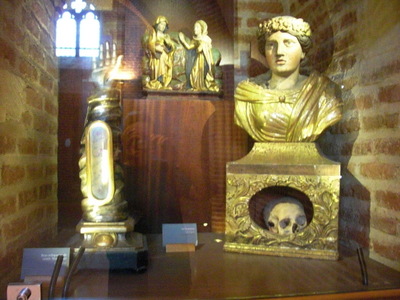
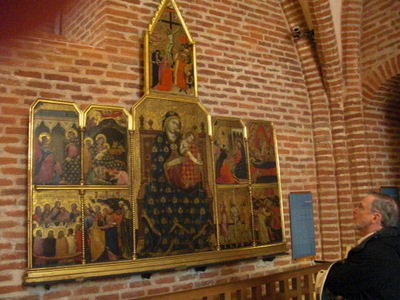 Then we once more followed the line of light sabers (not illuminated at that time of the morning) back up to the cathedral to plunk down our 3 euros each for audioguides, access to the choir, and access to the treasury. They recommended we climb the stairs to the treasury first, where the audioguides provided no information, then pick up the audioguides back down at the bottom before visiting the choir.
Then we once more followed the line of light sabers (not illuminated at that time of the morning) back up to the cathedral to plunk down our 3 euros each for audioguides, access to the choir, and access to the treasury. They recommended we climb the stairs to the treasury first, where the audioguides provided no information, then pick up the audioguides back down at the bottom before visiting the choir.
The treasure didn't turn out to be such a much. It contained mostly (a) art, like the altarpiece shown at the right, of a sort that doesn't appeal to us; (b) reliquaries, some empty and some clearly displaying bones, like the ones shown at the right; and (c) elaborately embroidered priestly vestments, some embroidered in precious metals. I tried to take photos of the those last, but the glare on the cases was hopeless.
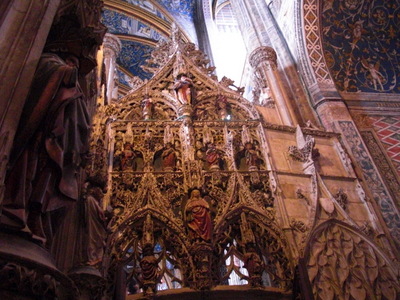
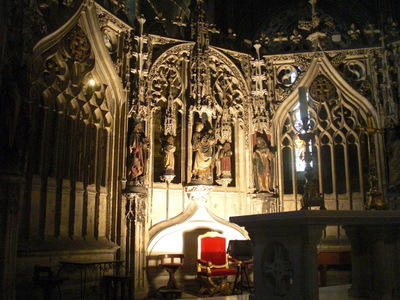 The audioguide was a good one, providing a lot of information about both the choir and the nave. At the left is a closer view of a section of the rood screen. The dim light makes it appear pinkish in my photos, but it was actually quite white, and the carving was amazing.
The audioguide was a good one, providing a lot of information about both the choir and the nave. At the left is a closer view of a section of the rood screen. The dim light makes it appear pinkish in my photos, but it was actually quite white, and the carving was amazing.
At the right is a portion of the carved stone altarpiece behind the main altar, done in the same white stone and in the same style. The ceremonial chair below it provides scale. Much of the area in the choir was covered with scaffolding (they warned us about that at the entrance), but the parts that were exposed were incredibly detailed in carving, painting, etc. The audioguide provided as much or as little information as you wanted about, e.g, the personages portrayed in the statues and the materials used in construction. Most parts of the narrative ended with "for more information on X, press the yellow key; for more information on Y, press the green key."
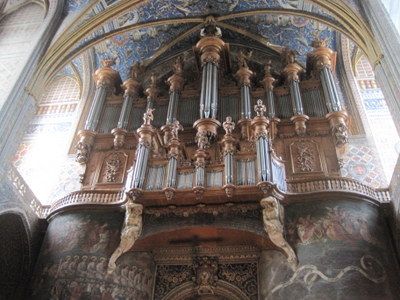
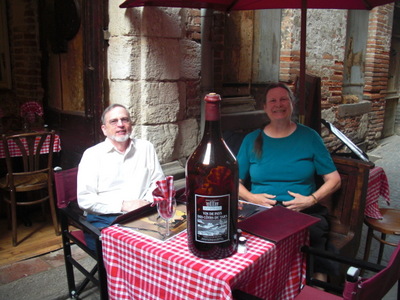 In particular, out in the nave again, the guide drew our attention to the organ, which we had only glanced at before. It apparently has some 10,000 pipes, only about a 10th of which are visible from the nave. It's one of the largest in the world, and you could buy CD's of recitals on it in the gift shop (we didn't). It had a couple of carved heads hanging from it (too small to see in this shot) that looked as though they might have articulated jaws, but I couldn't be sure, even with binoculars.
In particular, out in the nave again, the guide drew our attention to the organ, which we had only glanced at before. It apparently has some 10,000 pipes, only about a 10th of which are visible from the nave. It's one of the largest in the world, and you could buy CD's of recitals on it in the gift shop (we didn't). It had a couple of carved heads hanging from it (too small to see in this shot) that looked as though they might have articulated jaws, but I couldn't be sure, even with binoculars.
When our necks ached from studying the ceiling and we'd listened to everything the guides had to say, we turned them in and ducked down into a little sunken street we had marked earlier as promising for lunch at Le Petit Voisin (the Little Neighbor). The owner offered to take our photo, and when we agreed, he added this giant plastic wine bottle (advertising wines of the Tarn valley) to the frame.
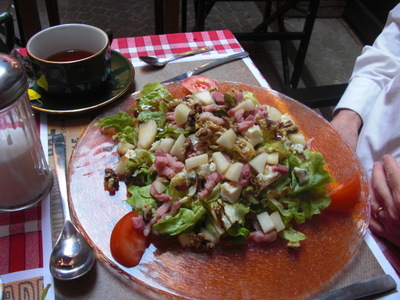
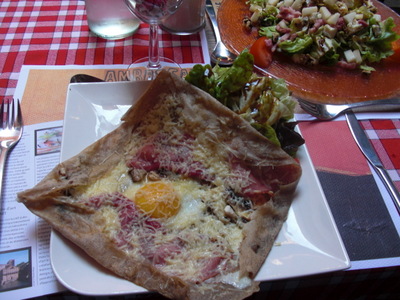 The restaurant's menus were all named for famous French singers (well, francophone singers, as Jacques Brel was included), but we ordered our usual sorts of things.
The restaurant's menus were all named for famous French singers (well, francophone singers, as Jacques Brel was included), but we ordered our usual sorts of things.
David had a salad topped with lardons, walnuts, Roquefort, and diced pear, which he raved about. (He started out shoving the fruit aside, saying "There's plenty of pear here; please help yourself." Then he tasted it with the Roquefort and revoked the offer.) We've since copied it at home, with great success.
I had another "galette complète," this one with mushrooms rather than stewed onions. Excellent.
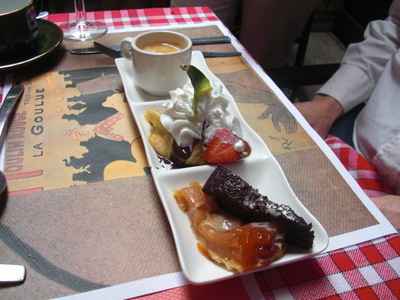
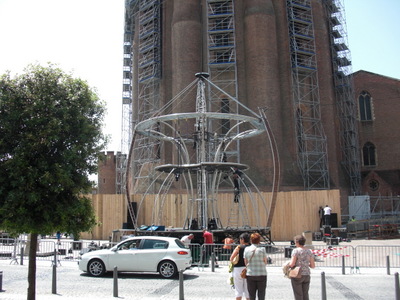 For dessert, we split the desserts that came with David's decaf "café gourmand"—a thin slice of rich chocolate cake, a thin slice of caramelized apple tart, and a folded-up chocolate-filled crêpe topped with whipped cream, a strawberry, and a pineapple leaf. As you can see from the photos, the paper placemats portrayed Toulouse-Lautrec posters.
For dessert, we split the desserts that came with David's decaf "café gourmand"—a thin slice of rich chocolate cake, a thin slice of caramelized apple tart, and a folded-up chocolate-filled crêpe topped with whipped cream, a strawberry, and a pineapple leaf. As you can see from the photos, the paper placemats portrayed Toulouse-Lautrec posters.
We wound up linger long after dessert, chatting with the couple at the next table and the younger couple at the table beyond. David even got to pet their dog, a charming Labrador-border collie mix, who has separation issues. He's a rescue, and at home (in Brussels, where they live) he can be left alone just fine while they go to work, but on vacation he panics the moment they're out of his sight, so he goes everywhere with them. The younger couple live and work in Paris, although she's Italian and he's from Colombia.
As 2 p.m. approached, though, we bid them farewell to go catch the little white train. For couple of days, we'd been watching the assembly of the strange apparatus shown to the right of the "café gourmand," and we were pleased to find that posters had at last appeared explaining what it was for. The following night the "Nuits Pastels" would take place, including a concert, light show, dancing, and circus acts. "Pastel" is French for "woad" (Isatis tinctoria, Brassicaceae) a plant that produces a beautiful blue dye, which was a major source of income for this region until it was replaced by indigo, which contains higher concentration of the same coloring agent. "Nuits Pastels" sounds a lot better than "Woad Nights."
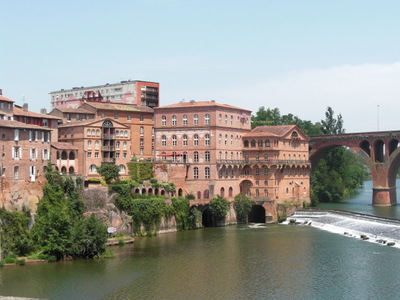
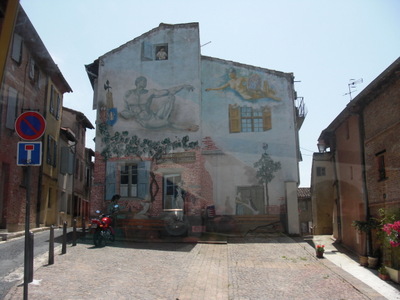 The white train, which departed from a spot right across from the Office de Tourisme (often the case), took us farther afield than we had been before. It circled the cathedral, then took us over the old bridge, did a loop on the far bank (passing by our restaurant of the night before), then came back over the new bridge, giving me a chance to get a good photo (from the old bridge) of the Mercure hotel (left). One of the things we learned from the narration was that the river was once lined, at this point, with water-powered pasta factories, and the Mercure has taken one of them (a UNESCO World Heritage site) over and restored it. One of its restaurant is called "La Vermicellerie" and the other "Le Moulin" (The Mill).
The white train, which departed from a spot right across from the Office de Tourisme (often the case), took us farther afield than we had been before. It circled the cathedral, then took us over the old bridge, did a loop on the far bank (passing by our restaurant of the night before), then came back over the new bridge, giving me a chance to get a good photo (from the old bridge) of the Mercure hotel (left). One of the things we learned from the narration was that the river was once lined, at this point, with water-powered pasta factories, and the Mercure has taken one of them (a UNESCO World Heritage site) over and restored it. One of its restaurant is called "La Vermicellerie" and the other "Le Moulin" (The Mill).
On a second loop, on the near bank but farther beyond our hotel than we had ventured, we passed this great mural.
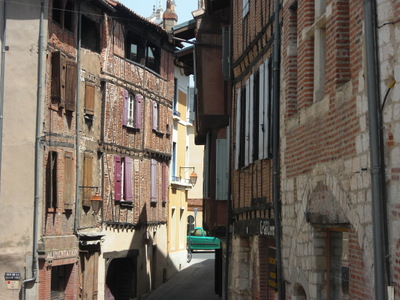
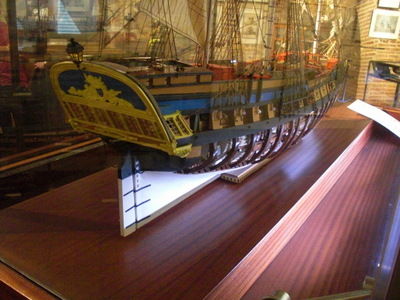 Another favorite son of Albi was Jean-François de Galaup, comte de Lapérouse, generally referred to just as Lapérouse. We'd walked by his statue several times (checking, the first time, to make sure it wasn't actually George Washington), and I knew vaguely that he was an explorer, but the narration in the petit train told more about him and piqued our interest.
Another favorite son of Albi was Jean-François de Galaup, comte de Lapérouse, generally referred to just as Lapérouse. We'd walked by his statue several times (checking, the first time, to make sure it wasn't actually George Washington), and I knew vaguely that he was an explorer, but the narration in the petit train told more about him and piqued our interest.
So when the train ride ended, we set off to tour his museum, which is just behind the Mercure hotel in the photo above, at the far end of the new bridge. On the way, we passed this street of old half-timbered houses.
After a distinguished naval career, Lapérouse was appointed in 1785 by Louis XVI to lead an expedition around the world. He set off across the Atlantic with two ships, the Compass and the Astrolabe, and visited Paraguay, Cape Horn, Chile, Easter Island, Hawaii, Alaska, California, the Mariannas, Macao, the Philippines, Kamchatka, the Friendly Islands, Botany Bay (yes, in that order), and finally Vanikoro Island (southeast of New Guinea), where, three years after leaving France, his two ships were wrecked on the islands fringing reefs in a storm and he was presumably killed. Some survivors settled on the island, where some were killed by natives and some set off in a home-made boat and were never heard from again. Because of the many ports of call, and because the naturalist on the cruise left the ships and made his way home overland from Kamchatka, considerable news of the voyage and a lot of the data collected got back to France.
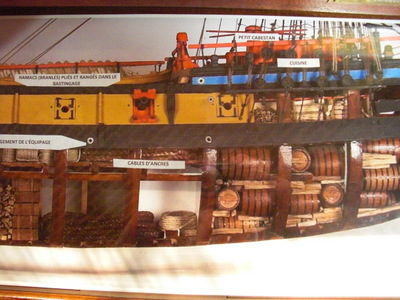
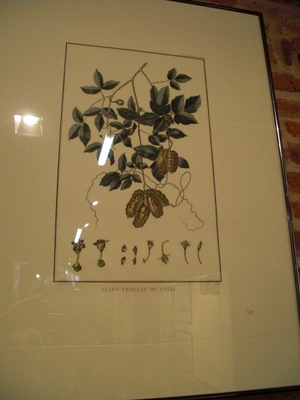 The ships have been located and are now under archeological exploration (a film on that subject was running continuously at the museum. The plans of the ships haven't survived but considerable research has gone into plausible reconstructions, like the one to the right of the image of the half-timbered houses, which is a very detailed and carefully labeled cutaway.
The ships have been located and are now under archeological exploration (a film on that subject was running continuously at the museum. The plans of the ships haven't survived but considerable research has gone into plausible reconstructions, like the one to the right of the image of the half-timbered houses, which is a very detailed and carefully labeled cutaway.
At the right is a botanical illustration of a "female liana" from Chile (displayed under glass, hence the reflections and flares).
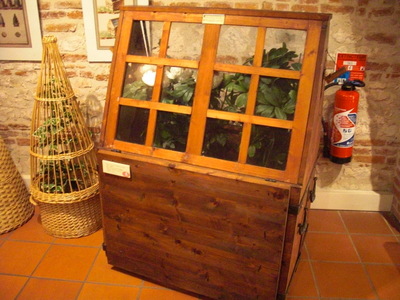
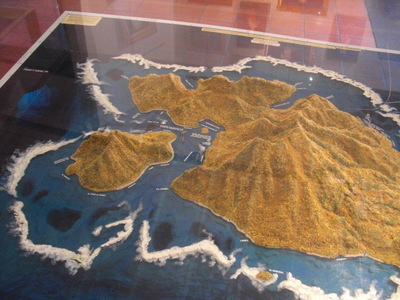 I was very interested to see the reconstructions of the sort of arrangements made for bringing home live plant speciments—both wicker baskets of different sizes and shapes and actual portable wooden greenhouses. I guess you would need the latter if you were going to collect plants in Hawaii and then take them with you to Alaska. What amazes me is that the naturalist was allowed to take up so much room on such tightly crowded ships!
I was very interested to see the reconstructions of the sort of arrangements made for bringing home live plant speciments—both wicker baskets of different sizes and shapes and actual portable wooden greenhouses. I guess you would need the latter if you were going to collect plants in Hawaii and then take them with you to Alaska. What amazes me is that the naturalist was allowed to take up so much room on such tightly crowded ships!
At the right is a scale model of Vanikoro. The spots where the ships were wrecked is actually on the far side, away from the camera.
It was then a long walk home, but definitely worth the side trip.
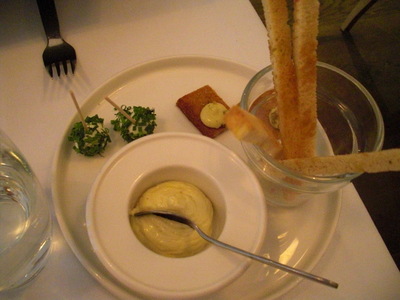
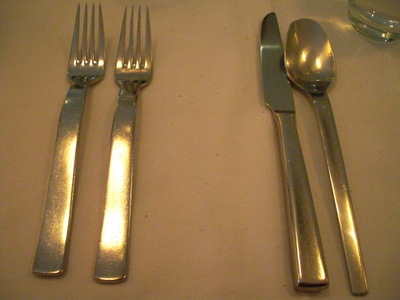 For dinner, we walked just a couple of blocks, to "l'Epicurien," a few doors from the theater I had been directed to in my question for the GM guide. The amuse-bouche was three-fold: little cheese balls on sticks rolled in fresh chives (excellent), little rectangular savory cookies topped with dabs of something cheeselike, and tall, thin, crisp toast fingers to dip into a dish of a creamy substance, perhaps also cheese based. The waiter never told us what they were.
For dinner, we walked just a couple of blocks, to "l'Epicurien," a few doors from the theater I had been directed to in my question for the GM guide. The amuse-bouche was three-fold: little cheese balls on sticks rolled in fresh chives (excellent), little rectangular savory cookies topped with dabs of something cheeselike, and tall, thin, crisp toast fingers to dip into a dish of a creamy substance, perhaps also cheese based. The waiter never told us what they were.
The flatware was of a distinctive design that David remarked looked as though it were designed by Maillol.
I ordered from the "Bistronomie" menu and David from the "Gastronomie" menu.
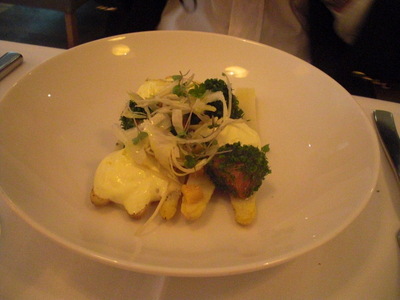
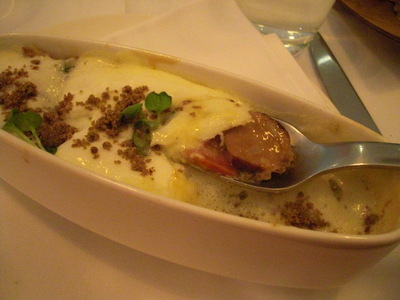 First course, David: White asparagus, salmon marinated with herbs, "foam like a mayonnaise," croutons, and paper-thin sliced raw fennel.
First course, David: White asparagus, salmon marinated with herbs, "foam like a mayonnaise," croutons, and paper-thin sliced raw fennel.
First course, me: Eggs baked with slices of fresh and dry sausage under a foam of Laguiole cheese. I think the foam was applied after baking, then sprinkled with crispy crumbles of some sort. Good, but undersalted, I thought. Also so hot that it was a while before I could get near it. On the spoon, you can see some egg and a slice of each kind of sausage.
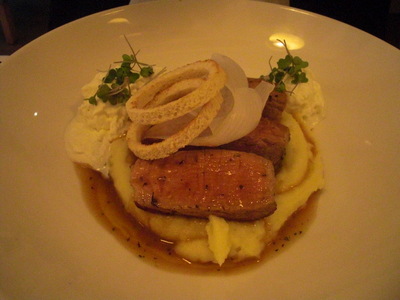
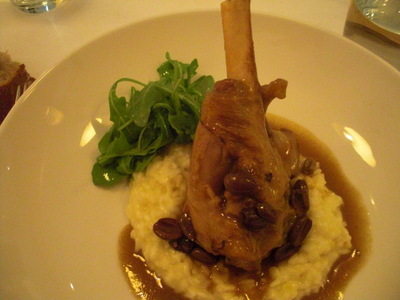 Main course, David: Roasted boneless rack of veal, mashed potato, French style green peas, sweet onions cooked two ways (slow simmered and roasted crisp), smoked bacon cream, and thyme. Excellent veal.
Main course, David: Roasted boneless rack of veal, mashed potato, French style green peas, sweet onions cooked two ways (slow simmered and roasted crisp), smoked bacon cream, and thyme. Excellent veal.
Main course, me: Slowly braised lamb shank with olive and olive sauce, on a bed of lemon risotto. Huge, but delicious and fork tender. On the side, a little salad of arugula. I'm going to have to do more with lamb shanks . . .
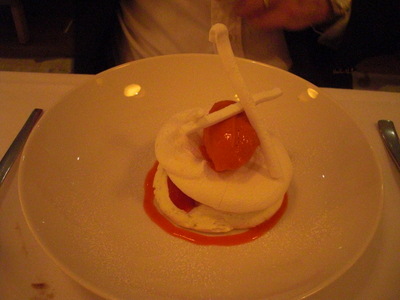
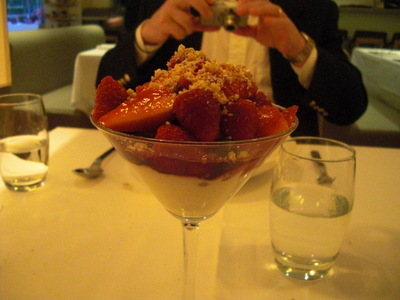 Dessert, David: Strawberry Pavlova (crisp meringue, whipped cream, and fresh fruit), with house-made strawberry sorbet. The meringue was a little chewy in places, but David was very happy with it nonetheless.
Dessert, David: Strawberry Pavlova (crisp meringue, whipped cream, and fresh fruit), with house-made strawberry sorbet. The meringue was a little chewy in places, but David was very happy with it nonetheless.
Dessert, me: Marinated red fruits (mostly strawberries and raspberries, a few blueberries) with mascarpone mousse, and crumble topping. I don't know what the fruit was marinated in, maybe just sugar, but it was outstanding—just sweet enough and very tender.
We had a long conversation with the waiter about other very good restaurants in the region (all of which we had visited in the last few days). The decor included a set of moose antlers balanced on the back of a banquette and an antique clockwork "tourne-broche" (spit turner).
previous entry
List of Entries
next entry

 Then we once more followed the line of light sabers (not illuminated at that time of the morning) back up to the cathedral to plunk down our 3 euros each for audioguides, access to the choir, and access to the treasury. They recommended we climb the stairs to the treasury first, where the audioguides provided no information, then pick up the audioguides back down at the bottom before visiting the choir.
Then we once more followed the line of light sabers (not illuminated at that time of the morning) back up to the cathedral to plunk down our 3 euros each for audioguides, access to the choir, and access to the treasury. They recommended we climb the stairs to the treasury first, where the audioguides provided no information, then pick up the audioguides back down at the bottom before visiting the choir.
 The audioguide was a good one, providing a lot of information about both the choir and the nave. At the left is a closer view of a section of the rood screen. The dim light makes it appear pinkish in my photos, but it was actually quite white, and the carving was amazing.
The audioguide was a good one, providing a lot of information about both the choir and the nave. At the left is a closer view of a section of the rood screen. The dim light makes it appear pinkish in my photos, but it was actually quite white, and the carving was amazing.
 In particular, out in the nave again, the guide drew our attention to the organ, which we had only glanced at before. It apparently has some 10,000 pipes, only about a 10th of which are visible from the nave. It's one of the largest in the world, and you could buy CD's of recitals on it in the gift shop (we didn't). It had a couple of carved heads hanging from it (too small to see in this shot) that looked as though they might have articulated jaws, but I couldn't be sure, even with binoculars.
In particular, out in the nave again, the guide drew our attention to the organ, which we had only glanced at before. It apparently has some 10,000 pipes, only about a 10th of which are visible from the nave. It's one of the largest in the world, and you could buy CD's of recitals on it in the gift shop (we didn't). It had a couple of carved heads hanging from it (too small to see in this shot) that looked as though they might have articulated jaws, but I couldn't be sure, even with binoculars.
 The restaurant's menus were all named for famous French singers (well, francophone singers, as Jacques Brel was included), but we ordered our usual sorts of things.
The restaurant's menus were all named for famous French singers (well, francophone singers, as Jacques Brel was included), but we ordered our usual sorts of things.
 For dessert, we split the desserts that came with David's decaf "café gourmand"—a thin slice of rich chocolate cake, a thin slice of caramelized apple tart, and a folded-up chocolate-filled crêpe topped with whipped cream, a strawberry, and a pineapple leaf. As you can see from the photos, the paper placemats portrayed Toulouse-Lautrec posters.
For dessert, we split the desserts that came with David's decaf "café gourmand"—a thin slice of rich chocolate cake, a thin slice of caramelized apple tart, and a folded-up chocolate-filled crêpe topped with whipped cream, a strawberry, and a pineapple leaf. As you can see from the photos, the paper placemats portrayed Toulouse-Lautrec posters.
 The white train, which departed from a spot right across from the Office de Tourisme (often the case), took us farther afield than we had been before. It circled the cathedral, then took us over the old bridge, did a loop on the far bank (passing by our restaurant of the night before), then came back over the new bridge, giving me a chance to get a good photo (from the old bridge) of the Mercure hotel (left). One of the things we learned from the narration was that the river was once lined, at this point, with water-powered pasta factories, and the Mercure has taken one of them (a UNESCO World Heritage site) over and restored it. One of its restaurant is called "La Vermicellerie" and the other "Le Moulin" (The Mill).
The white train, which departed from a spot right across from the Office de Tourisme (often the case), took us farther afield than we had been before. It circled the cathedral, then took us over the old bridge, did a loop on the far bank (passing by our restaurant of the night before), then came back over the new bridge, giving me a chance to get a good photo (from the old bridge) of the Mercure hotel (left). One of the things we learned from the narration was that the river was once lined, at this point, with water-powered pasta factories, and the Mercure has taken one of them (a UNESCO World Heritage site) over and restored it. One of its restaurant is called "La Vermicellerie" and the other "Le Moulin" (The Mill).
 Another favorite son of Albi was Jean-François de Galaup, comte de Lapérouse, generally referred to just as Lapérouse. We'd walked by his statue several times (checking, the first time, to make sure it wasn't actually George Washington), and I knew vaguely that he was an explorer, but the narration in the petit train told more about him and piqued our interest.
Another favorite son of Albi was Jean-François de Galaup, comte de Lapérouse, generally referred to just as Lapérouse. We'd walked by his statue several times (checking, the first time, to make sure it wasn't actually George Washington), and I knew vaguely that he was an explorer, but the narration in the petit train told more about him and piqued our interest. 
 The ships have been located and are now under archeological exploration (a film on that subject was running continuously at the museum. The plans of the ships haven't survived but considerable research has gone into plausible reconstructions, like the one to the right of the image of the half-timbered houses, which is a very detailed and carefully labeled cutaway.
The ships have been located and are now under archeological exploration (a film on that subject was running continuously at the museum. The plans of the ships haven't survived but considerable research has gone into plausible reconstructions, like the one to the right of the image of the half-timbered houses, which is a very detailed and carefully labeled cutaway.
 I was very interested to see the reconstructions of the sort of arrangements made for bringing home live plant speciments—both wicker baskets of different sizes and shapes and actual portable wooden greenhouses. I guess you would need the latter if you were going to collect plants in Hawaii and then take them with you to Alaska. What amazes me is that the naturalist was allowed to take up so much room on such tightly crowded ships!
I was very interested to see the reconstructions of the sort of arrangements made for bringing home live plant speciments—both wicker baskets of different sizes and shapes and actual portable wooden greenhouses. I guess you would need the latter if you were going to collect plants in Hawaii and then take them with you to Alaska. What amazes me is that the naturalist was allowed to take up so much room on such tightly crowded ships!
 For dinner, we walked just a couple of blocks, to "l'Epicurien," a few doors from the theater I had been directed to in my question for the GM guide. The amuse-bouche was three-fold: little cheese balls on sticks rolled in fresh chives (excellent), little rectangular savory cookies topped with dabs of something cheeselike, and tall, thin, crisp toast fingers to dip into a dish of a creamy substance, perhaps also cheese based. The waiter never told us what they were.
For dinner, we walked just a couple of blocks, to "l'Epicurien," a few doors from the theater I had been directed to in my question for the GM guide. The amuse-bouche was three-fold: little cheese balls on sticks rolled in fresh chives (excellent), little rectangular savory cookies topped with dabs of something cheeselike, and tall, thin, crisp toast fingers to dip into a dish of a creamy substance, perhaps also cheese based. The waiter never told us what they were.
 First course, David: White asparagus, salmon marinated with herbs, "foam like a mayonnaise," croutons, and paper-thin sliced raw fennel.
First course, David: White asparagus, salmon marinated with herbs, "foam like a mayonnaise," croutons, and paper-thin sliced raw fennel.
 Main course, David: Roasted boneless rack of veal, mashed potato, French style green peas, sweet onions cooked two ways (slow simmered and roasted crisp), smoked bacon cream, and thyme. Excellent veal.
Main course, David: Roasted boneless rack of veal, mashed potato, French style green peas, sweet onions cooked two ways (slow simmered and roasted crisp), smoked bacon cream, and thyme. Excellent veal.
 Dessert, David: Strawberry Pavlova (crisp meringue, whipped cream, and fresh fruit), with house-made strawberry sorbet. The meringue was a little chewy in places, but David was very happy with it nonetheless.
Dessert, David: Strawberry Pavlova (crisp meringue, whipped cream, and fresh fruit), with house-made strawberry sorbet. The meringue was a little chewy in places, but David was very happy with it nonetheless.